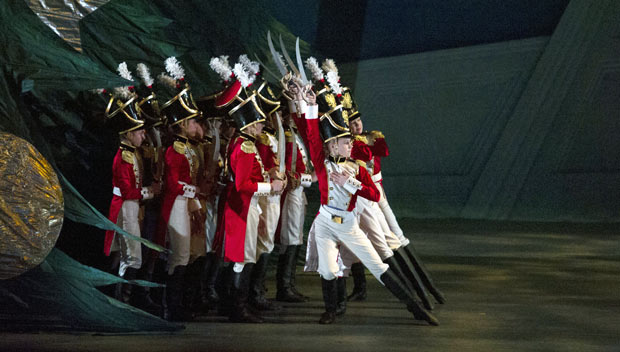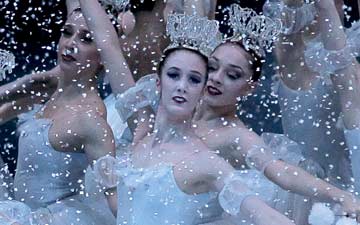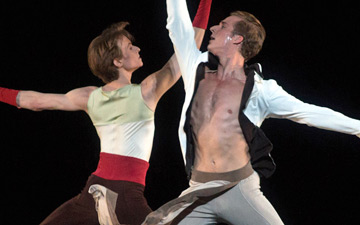
© Gene Schiavone. (Click image for larger version)
Sweet Dreams
American Ballet Theatre
The Nutcracker
New York, Brooklyn Academy of Music
16 December 2014
www.abt.org
bam.org
Just when New Yorkers were coming to fully embrace Alexei Ratmansky’s Nutcracker for American Ballet Theatre, it is leaving us for the West Coast. Who knows when it will be back. The production, now in its fifth season, could not be more different from George Balanchine’s at City Ballet; this may explain, in part, why it has taken time for it to sink into the audience’s consciousness. It’s brighter, stranger, less perfect and more mysterious. One of its most striking qualities—for a twenty-first century ballet—is its reliance on mime, and not just the usual “hello, how lovely you look” kind of mime. Here, the Sugarplum Fairy pretends to pluck out the entire harp introduction to the grand pas, note for note, on her little golden lyre, applying herself with great concentration. The fathers get drunk at the Christmas party and tell off-color jokes. Harlequin and Columbine act out an entire commedia dell’arte love scene. (Tonight, this little gem of a duet was danced with pinpoint charm by Luciana Paris and Arron Scott.) The Arabian dance is a comic skit about the battle of the sexes featuring a bald he-man and his four veiled concubines.

© MIRA. (Click image for larger version)
The ballet radiates warmth, but also an awareness of death. Every year I’m struck by how tenderly Clara and Fritz’s parents (Karen Uphoff and Eric Tamm) kiss in the opening kitchen scene, a young couple still very much in love. (The children shield their eyes.) And again later, during the formal dancing, he kneels down and kisses her hand, with all the gentleness of an admiring husband. No particular emphasis is placed on this private moment; there are about nine hundred other things going on. Some find the accumulation of activity in the ballet to be busy; to me it feels rich, layered, engaging to the eye and the heart. Life is like that; everything happens at once and if you blink, you’ll miss something.
It’s true, though, that the production would look better on a larger stage. Some dances, like the flower waltz, are positively cramped. As a result, the choreography for the flowers, which is set to some of the most sweeping music in the ballet, is less dynamic than it should be. (The Spanish dance is also a little run-of-the-mill.) More generally, Ratmansky’s style, full of compound steps that begin one way and end another, needs space in order to be seen clearly. The ballet is bursting at the seams.

© Gene Schiavone. (Click image for larger version)
It’s surprising, in a work for children, to see so many references to death. When Fritz pushes the Nutcracker boy to the floor, he just lies there, face down, and one begins to fear he may never get up again. In the battle against the rats, the toy soldiers tremble, afraid of dying. The snowflakes who whirl about the stage in the winter scene are pretty, but also sharp and dangerous. Their jumps, like those of the ill-mannered children in the first scene, emphasize the landing, not the takeoff. Again and again, their feet stab the floor. They lure the children into a lethal game, causing them to almost freeze to death in the forest. The end of the ballet, too, suggests loss.
In contrast the second act, set in an exotic, pseudo-Eastern playground rendered in flamboyant candy colors by Richard Hudson, is light, silly, almost parodic. One of the high points is the Chinese dance, a vaudevillian pas de deux filled with staccato cartwheeling turns, jitterbug steps, swinging lifts, split jumps. Skylar Brandt and Gabe Stone Shayer polished it off with charm and style; they looked like a flapper and her beau in Chinese drag. Brandt even threw in a quadruple pirouette as a parting gift.

© Gene Schiavone. (Click image for larger version)
The weakest character, conceptually, is Drosselmeyer; one gets the feeling that Ratmansky never quite decided whether he intended the character to be creepy (like Dr. Coppélius) or essentially friendly. He’s less central to the plot here than in other versions. On the other hand, Ratmansky’s knack for poetry reverberates in the idea of doubling the characters of Clara and the Nutcracker. At the climax of each act, the children come face to face with a second couple, embodying a future version of themselves. Briefly, the two couples dance side by side, sharing the same steps. Because the adult couple is a product of Clara’s imagination, it reflects her sensitive, excitable nature. The woman’s steps express confusion and a kind of emotional overload; her torso bends, her foot beats the air, she swoons. The man is protective, just as the Nutcracker boy was in the first act; as if to make this point more clear, his solo in the grand pas de deux ends with a pose from the boy’s first entrance.

© Gene Schiavone. (Click image for larger version)
The choreography of the two pas de deux is extremely difficult, intricate, full of shifts of weight and spinning lifts and tricky transitions. In tonight’s performance, Hee Seo and Cory Stearns pulled most of them off. Both are tall, elegant, reticent dancers with melting lines. Stearns is a steadfast and attentive cavalier who never pushes his technique too far. Seo is delicate and pliant, slightly languid and very touching. At times they looked ravishingly in sync, and in these moments, the full weight of Clara’s dream—a dream of love—came to life.
This Nutcracker is a ballet with a beating heart, and it will be missed. Now it’s California’s turn.

















You must be logged in to post a comment.